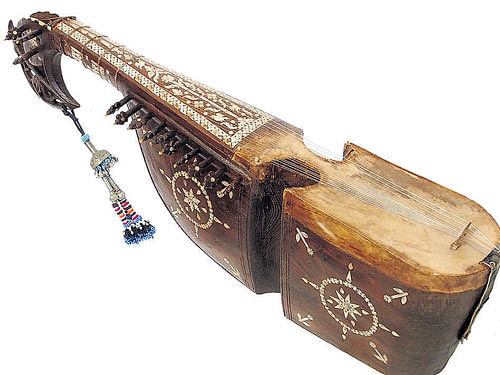
Native musical instruments fascinate me to no end, prompting me to explore all available information about them. One such recent experience has been with the rubab, a short-necked lute that is often associated with Kashmiri music. Enchanted by the melodious music it lends itself to, I learnt that it owes its origin to Afghanistan, and that it is one of the two national musical instruments of Afghanistan.
Carved out of a single piece of wood, rubab is used mainly by Baluch, Pashtun, Tajik, Turkish and Kurdish musicians, other than our own Kashmiri musicians. Though it derives its name from the Arab word rebab, which means ‘played with a bow’, in Central Asia it is played by plucking the strings.
However, a close look at the instrument, especially its narrow ‘waist’, suggests that it was, at some time, played with a bow. While the body of rubab is carved out of the trunk of a tree (traditionally a mulberry tree), the membrane covering the hollow bowl of the sound chamber is of animal skin, while the strings are either made of gut or nylon or metal.
A favourite with Afghan musicians, it’s known as the ‘lion of instruments’ owing to the importance it enjoys in Afghan music. Popular today as the Kabuli rubab, it finds several mentions in ancient texts dating back to the 7th century, including Sufi poems and Persian books. It also has a Punjabi connection by becoming an indispensable part of Punjabi hymns when the Muslim musician Bhai Mardana became the first disciple of Guru Nanak. According to history, when Guru Nanak sang the Gurbani, Bhai Mardana played it on his rubab, earning himself the sobriquet Rubabi. To this day, the rubab-playing tradition is followed by the Namdhari Sikhs.
The modern-day Kabuli rubab is quite different from the one mentioned in the ancient texts, which is known as Seni rubab, popular during the Mughal period. Seni rubab had a large hook at the back of its head, making it easier for a musician to sling it over the shoulder and play it even while walking. However, it’s no longer available today.
The popularity of rubab can be gauged from the fact that it has formed the basis of many Indian instruments, including the sarod, the saringda and the sarangi. And of course, the rubab-i-pamir of the Pamir region of Tajikistan.
So, the next time you are in Kashmir, you know what to look out for in musical performances.